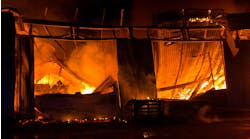Several months ago, ABRN published an article of mine on new technology and equipment your shop could use. Now that NACE is upon us, it's a great time to revisit that article and reconsider equipment innovations that could both improve your shop's performance and make your operation more profitable.
One new piece of technology I'm becoming a big fan of is called photogrammetry. It has to do with the use of digital images to measure objects. In the body shop, equipment with this technology can measure vehicle structures and determine damage, even damage that may be hidden.
Sound too good to be true? That's what I thought, too. Then I spent some time testing equipment that uses photogrammetry. Here's what I found and what you might want to consider as you invest in the next generation of shop tools.
Note: My interest here – as usual – is only to help shops. I receive no financial compensation for suggesting any products.
Technology and product background
Photogrammetry can provide shops with numerous measuring capabilities. Using photogrammetry equipment, a shop can measure a vehicle or specific areas of it. An image of the vehicle or vehicle areas is then produced and downloaded into a computer running a special damage analysis software program that examines the image and the measurements therein, and points to damage. And as for uncovering hidden damage, the technology can see through solid objects.
The product I tested is called the Matrix Wand, which is manufactured by Matrix Electronic Measuring Inc. Among the technological advantages the company touts are:
- Ease of use. Their literature says the Wand is as easy to use as a digital camera.
- More accurate estimates with fewer supplements.
- Precise digital and electronic measurements.
- Ability to verify repair quality.
- Ability to supply verifiable damage information to customers and insurers.
Testing background
I first heard about this product after being invited to a product presentation at the April Collision Industry Conference (CIC) meeting in Oklahoma City. Because I'm a skeptical person, I then attended a hands-on demonstration arranged by Gary Wano Jr., owner of GW & Son Collision in Oklahoma City.
The Wand was used on a 2009 BMW 3 Series that had taken a high collision. The headlamps and both grilles, along with the upper portion of the front bumper and hood all were damaged. I also noted that the vehicle had nose-dived under a bumper at less than 10 miles per hour.
We inspected the bumper absorber and reinforcement for damage but didn't find any. All of us at the demonstration concluded that the damage was isolated to the upper structure, with no lower structural damage. The product demonstrator used the Wand to take an image of the damage, which was then downloaded to his computer. Ten minutes later, the program results pointed to damage on the left lower rail, which had had a sway out by 5 mm and sag down of 6 mm.
We had the BMW placed on a measuring bench. Its measuring system recorded the same damage. Impressive, I thought, though I still wasn't convinced. More testing was needed, so I spent two additional days examining the Wand on more vehicles. I then asked the company if they would loan me a Wand to take back to Hawaii so I could test it on my own and thoroughly evaluate factors such as ease of use and accuracy.
Additional test results
The first vehicle I examined was a 2011 Honda Accord with damage to the left rail and left upper reinforcement area. The Wand indicated that the left rail was 8 mm back, with a sway of over 25 mm and sag of 6 mm. Dale Matsumoto, owner of Autobody Hawaii in Kailua Kona, timed the operation, which took 20 minutes from the moment I used the Wand to produce an image to the point of giving him a printout of the product's findings.
After the repair, I used the Wand again to check the repair accuracy. The information in the product printout noted that the vehicle had been returned to its correct width, length and height. I proceeded to take another "after picture" and then used a tram gauge to measure some of the repair points. The distances were exactly what the Wand indicated. Pretty remarkable, I thought.
I next turned my attention to an Autobody Hawaii customer who brought in a 2009 BMW convertible with a missing front bumper (it was sitting on the passenger seat). The customer said he caught the bumper on a concrete barrier in a parking lot and pulled it off as he was backing up.
While he waited for an estimate, I photographed the car with the Wand. I was able to measure from the strut tower to the core support and from the strut tower to two points on the bumper reinforcement. The Wand indicated that the left side of the bumper reinforcement was longer than the right side, meaning that the reinforcement was bent. The amazing thing to me was that this damage was not visible, but measurements from the Wand revealed the damage.
Interesting here, I asked the customer about the part of the bumper that had been caught on the barrier, and he stated it was on the driver's side. This corroborates the findings from the Wand.
Because the Wand was able to "see" this damage, the shop was able to order both the cover and reinforcement at the same time, instead of buying the cover first and later finding out (when it was to be installed) that the rebar also was bent. Keeping in mind that parts come from Honolulu once a week, the Wand's findings were particularly significant. It saved cycle time and prevented the need for extra paper work and phone calls.
The next vehicle I examined, a 2009 Nissan Xterra, provided more real-world proof of the savings the Wand technology could provide.
The Xterra had received damage to its right fender, right suspension and front bumper cover. An insurance adjuster had already looked at the Xterra and written an estimate calling for an aftermarket fender and cover. The Wand uncovered some serious problems with the estimate.
First, the gap on the fender was 3 mm larger with the aftermarket fender than the original on the left side. Even more significant was the frame damage that was overlooked.
The adjustor's estimate included no time for frame work. When the technician finished installing the right side suspension, he tried to align it. The right side, with all of the new parts, still had a negative caster. I had the vehicle put on a hoist and raised so that I could measure the bottom of the frame. I found that the right side was moved back at the lower control arm mounting brackets by 10 mm.
I then measured the under hood and bumper reinforcement. The Wand photo showed that the vehicle was 10 mm short on the right rail.
Based on this information, the shop contacted the adjustor with data supporting the need for additional frame labor and another alignment. The adjuster authorized the supplement. Two days later, the frame was pulled and realigned, and the vehicle was delivered the following week.
The vehicle was repaired correctly, with the insurance company having to pay for an additional eight days of car rental. I concluded that the extra expense and trouble could have been avoided with photogrammetry technology.
I've provided what I hope are some examples of just what this technology can do. If you're interested in other common shop measurements it can perform, consider these:
- Point-to-point measurements that are compared to data from an information provider.
- Vehicle width, length and height.
- Under hood and bottom of the vehicle.
- Door openings and "B" pillar positions.
- Engine cradle.
- Strut, knuckle, spindle and lower control arm.
Wand measurements also can determine if a sub frame has shifted, permitting the estimate time for this repair work to be added during the original estimate and not later when the vehicle goes to the alignment shop.
Product conclusions
Is it time for your shop to invest in photogrammetry technology? That's for you to decide. You'll want to examine the product yourself and consider other factors, such as return on investment. In other words, you'll be doing what you should as a professional repairer – staying current with industry technology and investing your money wisely. This is a good time of year to be thinking about your equipment options.




